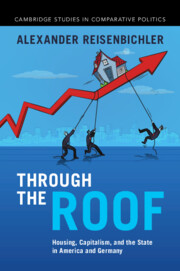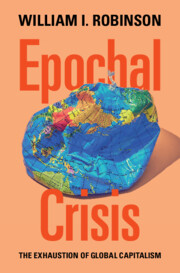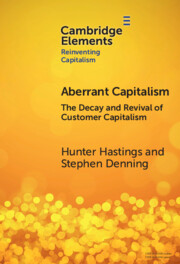Refine search
Actions for selected content:
73 results
12 - Anticolonial Action across the Black Atlantic
- from Part IV - On Method
-
-
- Book:
- Anticolonialism and Social Thought
- Published online:
- 16 September 2025
- Print publication:
- 25 September 2025, pp 281-302
-
- Chapter
- Export citation
From Adorno to 50 Cent: Financialized platform capitalism, Spotify, and the culture industry in the twenty-first century
-
- Journal:
- Finance and Society ,
- Published online by Cambridge University Press:
- 22 September 2025, pp. 1-25
-
- Article
-
- You have access
- Open access
- HTML
- Export citation
4 - Financializing the American Economy and Housing Market
-
- Book:
- Through the Roof
- Published online:
- 28 August 2025
- Print publication:
- 11 September 2025, pp 109-146
-
- Chapter
- Export citation

Through the Roof
- Housing, Capitalism, and the State in America and Germany
-
- Published online:
- 28 August 2025
- Print publication:
- 11 September 2025
Summoning the digital investor: Fintech apps and the shaping of everyday financial subjectivities
-
- Journal:
- Finance and Society ,
- Published online by Cambridge University Press:
- 22 August 2025, pp. 1-19
-
- Article
-
- You have access
- Open access
- HTML
- Export citation

Epochal Crisis
- The Exhaustion of Global Capitalism
-
- Published online:
- 21 August 2025
- Print publication:
- 04 September 2025
Chapter 21 - Performing Currency
- from Part III - Alternatives
-
-
- Book:
- Money and American Literature
- Published online:
- 03 July 2025
- Print publication:
- 17 July 2025, pp 363-380
-
- Chapter
- Export citation
Chapter 17 - Imagining and Occupying Wall Street
- from Part II - Histories
-
-
- Book:
- Money and American Literature
- Published online:
- 03 July 2025
- Print publication:
- 17 July 2025, pp 293-310
-
- Chapter
- Export citation
Green de-financialization: Toward a sustainable world economy?
-
- Journal:
- Finance and Society ,
- Published online by Cambridge University Press:
- 03 July 2025, pp. 1-21
-
- Article
-
- You have access
- Open access
- HTML
- Export citation
The Improvement Regime: Public Trusts, Real Estates, and India’s Urban Futurities
-
- Journal:
- Comparative Studies in Society and History , First View
- Published online by Cambridge University Press:
- 13 June 2025, pp. 1-24
-
- Article
-
- You have access
- Open access
- HTML
- Export citation
Chapter 15 - Financial Infrastructures in the Context of Financial Development
- from Part III - Organizations and Actors of Contemporary Financial Infrastructures
-
-
- Book:
- The Cambridge Global Handbook of Financial Infrastructure
- Published online:
- 21 May 2025
- Print publication:
- 05 June 2025, pp 179-191
-
- Chapter
-
- You have access
- Open access
- HTML
- Export citation
Chapter 21 - Derivatives Market Reforms and the Infrastructural Authority of Central Clearing Counterparties
- from Part III - Organizations and Actors of Contemporary Financial Infrastructures
-
-
- Book:
- The Cambridge Global Handbook of Financial Infrastructure
- Published online:
- 21 May 2025
- Print publication:
- 05 June 2025, pp 263-273
-
- Chapter
-
- You have access
- Open access
- HTML
- Export citation
The women’s inclusion agenda: Gender and everyday practices across registers of finance
-
- Journal:
- Finance and Society / Volume 11 / Issue 1 / April 2025
- Published online by Cambridge University Press:
- 27 January 2025, pp. 81-102
-
- Article
-
- You have access
- Open access
- HTML
- Export citation
Contemporary Financial Nationalism in Theory and Practice
-
- Journal:
- Nationalities Papers / Volume 53 / Issue 2 / March 2025
- Published online by Cambridge University Press:
- 13 May 2024, pp. 260-278
-
- Article
-
- You have access
- Open access
- HTML
- Export citation
Leviathan financialized?
-
- Journal:
- Finance and Society / Volume 10 / Issue 1 / April 2024
- Published online by Cambridge University Press:
- 05 March 2024, pp. 59-64
-
- Article
-
- You have access
- Open access
- HTML
- Export citation
Introducing The Rise of Central Banks
-
- Journal:
- Finance and Society / Volume 10 / Issue 1 / April 2024
- Published online by Cambridge University Press:
- 05 March 2024, pp. 51-58
-
- Article
-
- You have access
- Open access
- HTML
- Export citation
Response to my critics
-
- Journal:
- Finance and Society / Volume 10 / Issue 1 / April 2024
- Published online by Cambridge University Press:
- 05 March 2024, pp. 82-87
-
- Article
-
- You have access
- Open access
- HTML
- Export citation
Leveraging uncertainty, market-power, and fiscal opacity: The growth of financial security states
-
- Journal:
- European Journal of Sociology / Archives Européennes de Sociologie / Volume 65 / Issue 2 / August 2024
- Published online by Cambridge University Press:
- 29 February 2024, pp. 248-280
-
- Article
-
- You have access
- Open access
- HTML
- Export citation

Aberrant Capitalism
- The Decay and Revival of Customer Capitalism
-
- Published online:
- 21 February 2024
- Print publication:
- 14 March 2024
-
- Element
- Export citation
Global Financialization and Local Labour Acquisition in China's Platform Economy
-
- Journal:
- The China Quarterly / Volume 259 / September 2024
- Published online by Cambridge University Press:
- 25 January 2024, pp. 785-803
- Print publication:
- September 2024
-
- Article
- Export citation
